 Transferring
Wounded From Minesweeper to LST
Transferring
Wounded From Minesweeper to LSTMitchell Jamieson #225
Ink & wash, June 1944
88-193-IA
The German defenses on the Normandy beaches were formidable and well designed, while the troops manning them were efficient and well-disciplined veterans. They imposed a terrible toll on the Allies. Every battle has its wounded and dead – Normandy was no different.
 Transferring
Wounded From Minesweeper to LST
Transferring
Wounded From Minesweeper to LST
Mitchell Jamieson #225
Ink & wash, June 1944
88-193-IA
Early D-Day morning, survivors and casualties were brought on board from an Allied minesweeper which had hit a mine and sunk the preceding evening. They were picked up by another minesweeper and given emergency first aid, but their medical supplies were nearly exhausted. Allied LSTs had been fitted out as temporary hospital ships with two Navy doctors and an Army doctor, as well as several pharmacist mates. Operating rooms had been rigged up in the rear of the tank deck and screened off. These improvised and rough facilities did much to save lives before moving the victims further to the rear and more sophisticated medical treatment.
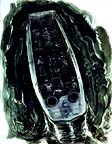 Voyage
Through Pain
Voyage
Through Pain
Mitchell Jamieson #269
Ink, 1944
88-193-KG
An assault craft returned to an LST from the Utah beachhead in Normandy loaded with the first wounded of the landing.
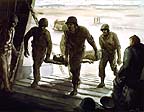 Taking
the Wounded Aboard
Taking
the Wounded Aboard
Alexander P. Russo #21
Watercolor, 1944
88-198-U
After the fighting moved inland, beach obstacles were cleared away and the danger from German artillery subsided. LSTs were able to safely move in to load Allied wounded from the continuing D-Day attack for transportation to England.
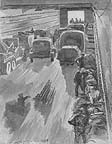 Wounded
on Tank Deck of LST
Wounded
on Tank Deck of LST
Mitchell Jamieson #R
Pen & wash, June, 1944
88-193-PY
Wounded Allied troops were placed where they would be out of the elements, and on an LST that meant the covered tank deck. Later the wounded were transferred to hospital ships and vessels with better facilities for transport back to England.
 Wounded
Being Treated Aboard LST
Wounded
Being Treated Aboard LST
Mitchell Jamieson #221
Watercolor, June 1944
88-193-HW
This was the scene in part of the crew's quarters used for treating the wounded, mostly burn cases. To the left, one of the men was given plasma to compensate for loss of blood. Others were bandaged. A seaman seated at the table kept a record of treatment and the condition of patients. In the first days of the invasion, after unloading their cargo of men and vehicles LSTs brought back wounded and prisoners in constant streams. Then, after discharging them in England, the loading would start again. Soon they would be underway again, perhaps bound for a different beach this time.
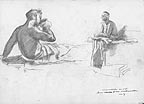 Sick
Bay
Sick
Bay
Mitchell Jamieson #V-69
Charcoal & wash, circa, 1944
88-193-SV
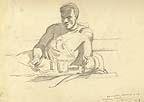 Casualty
Aboard LST Eating Chow
Casualty
Aboard LST Eating Chow
Mitchell Jamieson #V-32
Charcoal & wash, June, 1944
88-193-RI
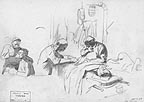 Causalities
on LST
Causalities
on LST
Mitchell Jamieson #V-69 (reverse side)
Charcoal & wash, circa, 1944
88-193-SV
1 2 3 4 5 6 7 8 9 10 11 12 13 14 15 16 17 18 19 20 21 22 23 24 25